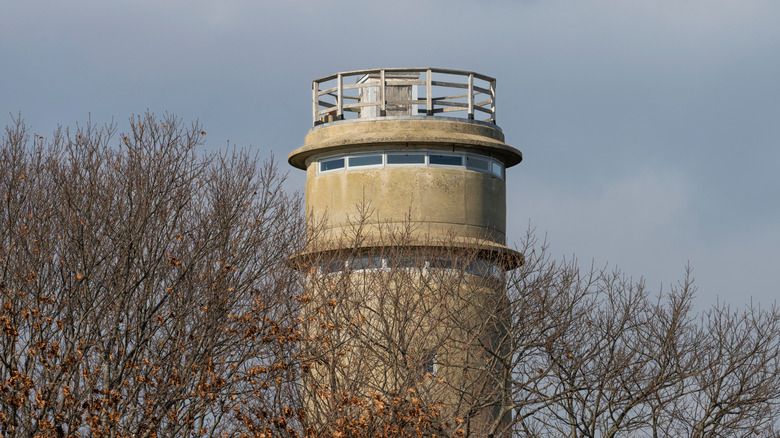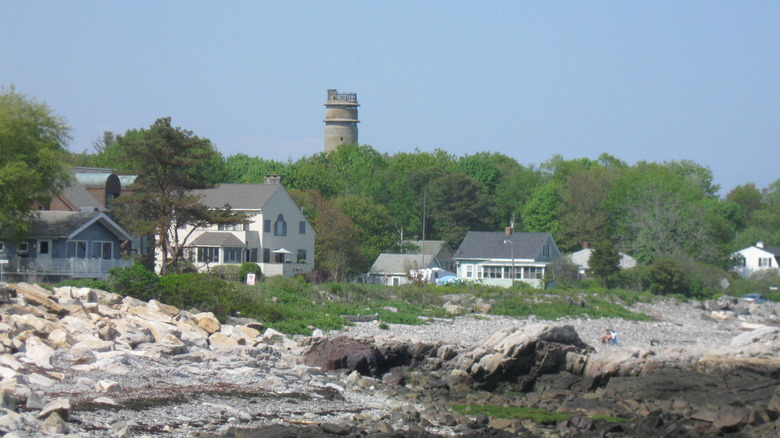New Hampshire's Only Standing WWII Watchtower Is A Historic Gem With Stunning Panoramic Views
Many know New Hampshire for hosting some of the best fall foliage tours in New England, but it's also a state packed with fascinating history. For one thing, it's where the mysterious site of America's own Stonehenge is located. Then, on the state's coast, there are relics from its important role in defense during World War II. One of the most striking is the Pulpit Rock Tower in Rye, New Hampshire. It may seem modest compared to other, grand monuments of war, but the tower is a rare survivor of America's home-front defenses and a reminder that the war was closer to home than we often realize.
At first glance, the Pulpit Rock Tower may look like a lighthouse, but its role was to guard rather than to guide. Built in 1943, soldiers watched from the top to look out for enemy ships. There were originally 14 of these watchtowers built along New Hampshire's coastline, but this is the only one left standing and still almost in its original condition, maintained and preserved by the Friends of Pulpit Rock Tower. Though visitors usually can't go inside, the tower is open for special interior tours a couple of times a year if you catch the right date, with great views out from the observation windows.
Pulpit Rock Tower's strategic role in military history
During World War II, the threat of German U-boats encroaching upon the U.S.'s Atlantic coast was real. At eight stories high — or 73 feet — the Pulpit Rock Tower was one of a squad of watchtowers which soldiers could station themselves at and detect potential enemies from the top. From the roof deck, soldiers even watched out for enemy aircraft. If enemies were detected, the tower guards could alert nearby Fort Dearborn, which was armed with defense artillery, and give precise coordinates for the fort to aim at. The location of the Pulpit Rock Tower, in particular, was critical: Both the tower and Fort Dearborn were positioned near the Portsmouth Naval Shipyard, a military facility that they were designed to protect.
After the war, the tower was used on and off for various purposes. It revived its role in defense during the Cold War starting in the 1950s, when the U.S. Navy capitalized on it. In the 1970s, it was acquired by the State of New Hampshire Fish and Game Department. The department used it to look out for illegal offshore fishing. Eventually, it fell out of use, and the Friends of Pulpit Rock Tower was established to preserve the site. It was listed on the National Register of Historic Places in 2010.
How to visit the Pulpit Rock Tower
If you want to get a look inside the Pulpit Rock Tower, you have to time your visit around one of the few days it's open to the public, typically around Memorial Day and Veterans Day. Tours are a rare opportunity, because the Friends of Pulpit Rock Tower has to apply for a special permit to open it to the public. Inside, there are six flights of concrete stairs, followed by two ladders to get to the top two observation floors. From the top floors, you'll get stunning views out to New Hampshire's coast, including the Portsmouth Naval Shipyard.
You'll find the watchtower in Rye, a laidback New Hampshire beach town, just over an hour drive from Boston Logan International Airport. It's also just a few minutes away by car from the site of Fort Dearborn, which has been turned into a state park called Odiorne Point. It's definitely worth pairing your visit with the park, where you can walk among the fort's preserved concrete battery and relax by the ocean.


